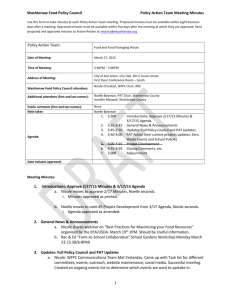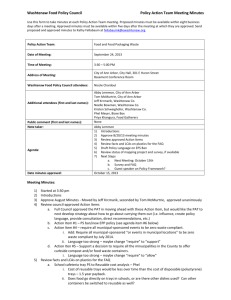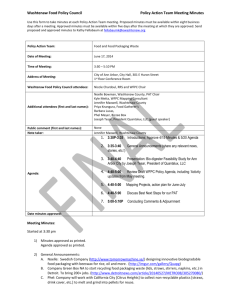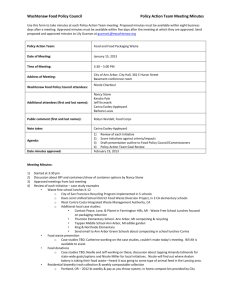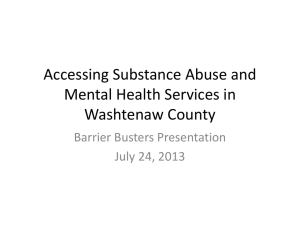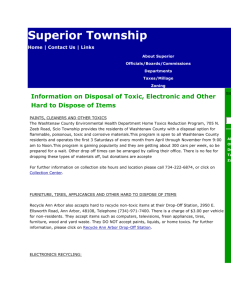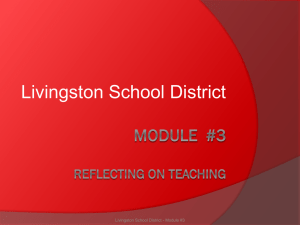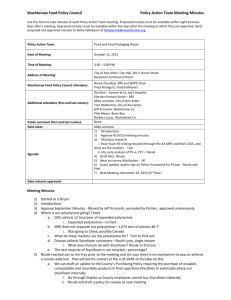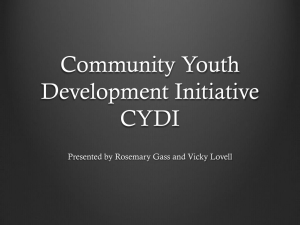STORMWATER DISCHARGE PERMIT APPLICATION
advertisement
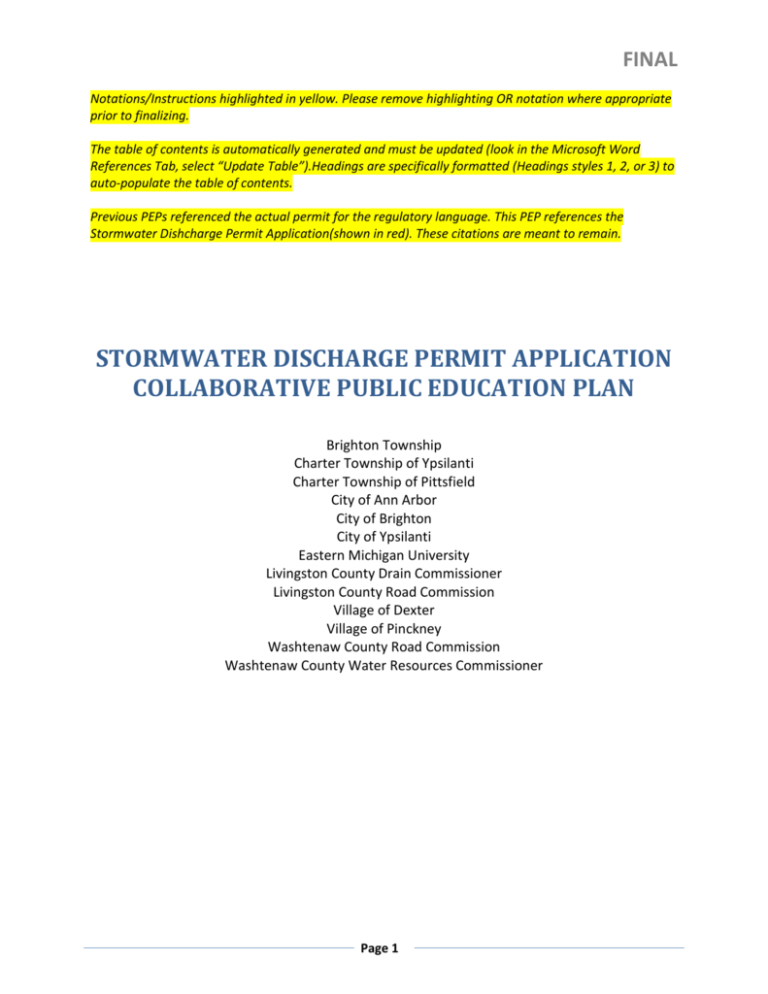
FINAL Notations/Instructions highlighted in yellow. Please remove highlighting OR notation where appropriate prior to finalizing. The table of contents is automatically generated and must be updated (look in the Microsoft Word References Tab, select “Update Table”).Headings are specifically formatted (Headings styles 1, 2, or 3) to auto-populate the table of contents. Previous PEPs referenced the actual permit for the regulatory language. This PEP references the Stormwater Dishcharge Permit Application(shown in red). These citations are meant to remain. STORMWATER DISCHARGE PERMIT APPLICATION COLLABORATIVE PUBLIC EDUCATION PLAN Brighton Township Charter Township of Ypsilanti Charter Township of Pittsfield City of Ann Arbor City of Brighton City of Ypsilanti Eastern Michigan University Livingston County Drain Commissioner Livingston County Road Commission Village of Dexter Village of Pinckney Washtenaw County Road Commission Washtenaw County Water Resources Commissioner Page 1 FINAL Table of Contents I. INTRODUCTION ....................................................................................................................................... 4 Purpose of Public Education Plan ............................................................................................................. 4 Federal Phase II Storm Water Regulations ............................................................................................... 4 Required Public Education Plan Elements ................................................................................................ 4 II. COLLABORATION OF WATERSHED PARTNERS ......................................................................................... 6 III. PROCEDURE FOR IDENTIFYING AND PRIORITIZING APPLICABLE PEP TOPICS ......................................... 6 Watershed-Wide Priority Topics ............................................................................................................... 6 IV. EXISTING AND PROPOSED COLLABORATIVE PUBLIC EDUCATION BMPs ................................................ 8 Activity #1: Distribute Informational Materials ................................................................................... 8 Activity #2: Distribute a Community Watershed Calendar .................................................................. 9 Activity #3: Content in Community Newsletters, Websites, Social Media ........................................ 10 Activity #4: Local Newspaper and Web Advertisements ................................................................... 10 Activity #5: Promote Water Resource Protection Workshops .......................................................... 11 Activity #6: Promote and Support Volunteer Stream Monitoring ..................................................... 11 Activity #7: Promote and Support Storm Drain Labeling (for communities with storm drains) ........ 12 Activity #8: Promote Riparian Land Management Information......................................................... 12 Activity #9: Conduct Outreach at Local and Regional Fairs and Community Events .......................... 13 Activity #10: Promote County-Wide Complaint Tracking and Response Systems............................. 13 V. EXISTING AND PROPOSED COUNTY-WIDE PUBLIC EDUCATION BMPs.................................................. 14 Activity #11: Livingston County Household Hazardous Waste Reduction Program .......................... 14 Activity #12: Livingston County Prescription Drugsand Personal Care Products Disposal Program . 14 Activity #13: Livingston County Electronic Waste Reduction Program ............................................. 15 Activity #14: Stream and River Crossing Road Signs Livingston and Washtenaw Counties .............. 15 Activity #15: Washtenaw County Community Partners for Clean Streams ....................................... 16 Activity #16: Washtenaw County Pollution Prevention Inspections ................................................. 16 Activity #17: Washtenaw County Issues of the Environment Radio Show ........................................ 16 Activity #18: Washtenaw County Environmental Excellence Awards ............................................... 17 Activity #19: Washtenaw County Fats, Oils, and Grease and Litter Reduction ................................. 17 Activity #20: Washtenaw County River Safe Homes Program ............................................................ 17 Activity #21: Washtenaw County/Ann Arbor Residential Rain Garden Program ............................... 18 Activity #22: Washtenaw County Home Toxics Reduction Program .................................................. 18 Activity #23: Washtenaw County Drug Take-Back Program .............................................................. 19 VI. EXISTING AND PROPOSED INDIVIDUAL PUBLIC EDUCATION BMPs ..................................................... 19 Activity #1: Description ...................................................................................................................... 19 Page 2 FINAL VII. OTHER INVOLVED ORGANIZATIONS ..................................................................................................... 19 VIII. EVALUATION OF EFFECTIVENESS ........................................................................................................ 20 IX. PERIODIC PROGRESS REPORT ............................................................................................................... 21 Exhibit A – Table of PEP Tasks by Topic and Activity Page 3 FINAL I. INTRODUCTION Purpose of Public Education Plan In accordance with the permit requirements for Federal Phase II Storm Water Regulations, this Public Education Plan (PEP) was prepared to instill within the residents, businesses, and officials of the communities in regulated watersheds a heightened level of awareness of the connection between individual actions and the health of their watershed and water resources. The objective of this plan is to promote, publicize, and facilitate watershed education for the purpose of encouraging the public to reduce the discharge of pollutants in storm water. Federal Phase II Storm Water Regulations A 1987 amendment to the Federal Clean Water Act required the U.S. Environmental Protection Agency (EPA) to develop regulations setting forth National Pollutant Discharge Elimination System (NPDES) permit application requirements for storm water discharges from municipal separate storm sewer systems (MS4s). An MS4 is a drainage system that discharges to waters of the State and is owned or operated by a federal, state, county, city, village, township, district, association or other public body of government. Such drainage systems may include roads, catch basins, curbs, gutters, parking lots, ditches, conduits, pumping devices, or man-made channels. Phase I of the NPDES regulations went into effect in 1990, which regulated discharges from communities with populations greater than 100,000. The rules for Phase II of the NPDES regulations were issued in 1999, requiring storm water discharge permits for communities with populations under 100,000 that have MS4s in “urbanized areas” as defined by the U.S. Bureau of the Census. In Michigan the Michigan Department of Environmental Quality (MDEQ) is administering the federal Phase II permitting process. This section can be updated to incorporate the current permitting program for Phase II as known. Required Public Education Plan Elements The PEP program is designed to promote, publicize, and facilitate education for the purpose of encouraging the public to reduce the discharge of pollutants in stormwater to the maximum extent practicable. The plan describes current and proposed best management practices (BMPs) to meet the minimum control measure requirements in a Public Education Plan (PEP). This section can be updated to incorporate the current permitting program for Phase II. Page 4 FINAL The PEP may involve watershed or regional partners collaborating to combine or coordinate existing programs for public stewardship of water resources. Permittees shall indicate if they are or will be working collaboratively with watershed or regional partners on any or all activities in the PEP during the permit cycle, (Stormwater Discharge Permit Application, Public Education Program (PEP) p. 3). The PEP is designed to implement a sufficient amount of educational activities to ensure that the targeted audiences are reached with the appropriate messages to the maximum extent practicable. The permittee shall identify applicable topics from the topics listed below, (Stormwater Discharge Permit Application, Public Education Program (PEP) p. 3). Each applicable topic shall be prioritized based on a procedure for assessing high-priority communitywide issues and targeted issues to reduce pollutants in stormwater runoff, (Stormwater Discharge Permit Application, Public Education Program (PEP) p. 3). A. Promote public responsibility and stewardship in the applicant(s) watershed. B. Inform and educate the public about the connection of the MS4 to area waterbodies and the potential impacts discharges could have on surface waters of the state. C. Educate the public on illicit discharges and promote public reporting of illicit discharges and improper disposal of materials into the MS4. D. Promote preferred cleaning materials and procedures for car, pavement, and power washing. E. Inform and educate the public on proper application and disposal of pesticides, herbicides, and fertilizers. F. Promote proper disposal practices for grass clippings, leaf litter, and animal wastes that may enter into the MS4. G. Identify and promote the availability, location, and requirements of facilities for collection or disposal of household hazardous wastes, travel trailer sanitary wastes, chemicals, yard wastes, and motor vehicle fluids. H. Inform and educate the public on proper septic system care and maintenance, and how to recognize system failure. I. Educate the public on and promote the benefits of green infrastructure and Low Impact Development. J. Promote methods for managing riparian lands to protect water quality. K. Identify and educate commercial, industrial and institutional entities likely to contribute pollutants to stormwater runoff. For all applicable topics, the PEP shall identify: Page 5 FINAL 1. 2. 3. 4. 5. Target audience. Key message. Delivery mechanism. Year and frequency the BMP will be implemented. Responsible party. A measurable goal with a measure of assessment shall be included for each BMP and as appropriate, a schedule for implementation (months and years), including interim milestones and the frequency of the BMP, (Stormwater Discharge Permit Application, Public Education Program (PEP) p. 3). The PEP shall provide the procedure for evaluating and determining the effectiveness of the overall PEP. The procedure shall include a method for assessing changes in public awareness and behavior resulting from the implementation of the PEP and the process for modifying the PEP to address ineffective implementation, (Stormwater Discharge Permit Application, Public Education Program (PEP) p. 3). II. COLLABORATION OF WATERSHED PARTNERS The permittees identified below have elected to meet the PEP requirements by working with each other and other watershed and regional partners to develop, submit, and implement a PEP that includes both collaborative and individual BMPs: • • • • • • • • • • • • • Brighton Township Charter Township of Ypsilanti Charter Township of Pittsfield City of Ann Arbor City of Brighton City of Ypsilanti Eastern Michigan University Livingston County Drain Commissioner Livingston County Road Commission Village of Dexter Village of Pinckney Washtenaw County Road Commission Washtenaw County Water Resources Commissioner III. PROCEDURE FOR IDENTIFYING AND PRIORITIZING APPLICABLE PEP TOPICS The public education topics A-K listed above in Section II were identified in the permit application. These topics are referred to by their corresponding letter in the Public Education BMPs below as well as on the PEP table. Watershed-Wide Priority Topics The procedure for identifying high-priority watershed-wide or targeted issues suited for collaborative public education efforts includes: Page 6 FINAL A review of Watershed Management Plans for both the Huron River in the Ann Arbor-Ypsilanti Metropolitan Area (Middle Huron) and the Huron Chain of Lakes including any established Total Maximum Daily Loads for waterbodies in each area. A review of data from the Water Quality Monitoring Program. A review of the effectiveness of PEP activities (both the accumulated measures of the PEP’s individual activities and a measure of the sum of all the activities including results from a survey of residents administered in conjunction with the distribution of a Community Watershed Calendar, Activity #2 below and referenced in Section VIII. Evaluation of Effectiveness). Topics identified by permittees at quarterly group meetings and periodic subcommittee meetings prior to and throughout the permit cycle. Discussion and input from the permitted entities regarding individual jurisdictional versus watershed-wide needs, potential public outreach opportunities, and existing and future programs. Any additional procedural steps for identifying high-priority or targeted issues by individual permittees include: Individual permittees will want to include any additional steps they may have taken to review and identify individual priority topics as part of the procedure here. The high priority community-wide issues and targeted issues are: High levels of phosphorus in stormwater runoff from most monitored tributaries indicating broad sources; High E. coli counts in some targeted tributaries in the Middle Huron (Mill and Honey Creeks, and tributaries draining to the Huron River between Argo and Geddes Ponds); High conductivity levels (indicating potential dissolved contaminants) in most Middle Huron tributaries; Flashy flows in Middle Huron streams indicating the need for infiltration and storage across the watershed; A need for greater protection of riparian areas to reduce erosion and slow and treat stormwater runoff; and Survey results indicating a need for continued education about stormwater pollution and residential responsibilities. The high priority community-wide issues and targeted issues were used to prioritize topics A-K for collaborative efforts. Existing and Proposed Collaborative Public Education BMPs include in some way all topics, but the emphasis will be on Collaborative High Priority Topics. Individual permittees may have additional or other priorities for individual education efforts as shown below and may address these in Existing and Proposed Individual Public Education BMPs: Individual permittees may rank individual priority topics high/medium/low in the table below or prioritize topics specific to their MS4. Collaborative Permittee Priority Priority Level High Topic Letter A Topic Description Public responsibility and stewardship in the watershed. Page 7 FINAL High B The connection of the MS4 to area waterbodies and the potential impacts of discharges. High F Proper disposal practices for grass clippings, leaf litter, and animal wastes. High E Inform and educate the public on proper application and disposal of pesticides, herbicides, and fertilizers. High I Benefits of green infrastructure and Low Impact Development. High J Methods for managing riparian lands to protect water quality. Low H Proper septic system care and maintenance, and how to recognize system failure. Low C Illicit discharges and public reporting of illicit discharges and improper disposal of materials. Low G Identify and promote the availability, location, and requirements of facilities for collection or disposal of household hazardous wastes, travel trailer sanitary wastes, chemicals, yard wastes, and motor vehicle fluids. Low D Low K Promote preferred cleaning materials and procedures for car, pavement, and power washing. Identify and educate commercial, industrial and institutional entities likely to contribute pollutants to stormwater runoff. IV. EXISTING AND PROPOSED COLLABORATIVE PUBLIC EDUCATION BMPs To address each of the PEP requirements, the permittee will, individually or collaboratively, implement the following specific activities, which include a description, timeline, evaluation component, and the required topic that the activity meets. Activities will be completed with the involvement of responsible parties as noted in each activity description, and/or in cooperation with identified permitted communities. DEQ reads this as stating that unless otherwise specified where “permittee” is included in the responsible party all permittees will implement the activity. Time lines for implementation of proposed activities extend from (year 1) when implementation of the PEP begins to (year 5) when the permit expires. Activity #1: Distribute Informational Materials Delivery Mechanism: Print and digital materials such as tip cards, brochures, posters, website links, or graphics for emails, websites or social media sites developed by the Huron River Page 8 FINAL Key Messages: Target Audience: Year and Frequency: Goal: Assessment: Responsible Parties: Topics Addressed: Watershed Council (HRWC), or created by the Southeast Michigan Council of Governments (SEMCOG), or others will be utilized. Campaign materials will be distributed at municipal offices, events, on web sites, via cable access or direct mailed as appropriate. Materials contain information that covers required Topics A-K. For example, the SEMCOG campaign promotes key messages on proper use of fertilizer, car care, landscaping, storm drain awareness, household hazardous wastes, water conservation, pet care, green infrastructure, and riparian protection. Residents, visitors, public employees, businesses, industries, construction contractors and developers. Materials will be disseminated at least annually throughout the permit cycle. To increase visibility and awareness of watershed issues and the impacts of pollutants discharged to the MS4 among residents, visitors, public employees, businesses, industries, construction contractors, and developers through repeat messaging and information. Frequency and number, circulation or amount distributed; tracking of web hits to supporting pages; and/or phone calls and e-mails to the permittee for related information. SEMCOG has materials available free with membership or for purchase, HRWC develops materials under contract for permittees working collaboratively. Permittees will individually ensure distribution of materials to appropriate target audiences through their current channels of distribution, see Section VI Existing and Proposed Individual BMPs. DEQ will want to know specifically how individual permittees are distributing materials. We suggest you describe this in Section VI. Existing and Proposed Individual BMPs. A-K Activity #2: Distribute a Community Watershed Calendar Delivery Mechanism: Coordinated by HRWC, permittees will participate in the bulk printing and distribution of a Community Watershed Calendar to residents. The calendar will, at least once during the permit cycle, include a mechanism for collecting evaluative feedback to measure the effectiveness of the piece itself or that will measure overall PEP effectiveness, see Section VII Evaluation of Effectiveness. Key Messages: Calendars typically feature a different tip each month for increasing public awareness of watershed issues and improving personal actions affecting the health of their watershed. Topics/messages are likely to include key messages associated with A-J of the PEP topics that are suited for homeowners, such as general watershed stewardship; household hazardous waste disposal; proper lawn care; car washing; storm drain pollutants; pet waste; riparian land management; green infrastructure and LID; and illegal dumping in storm drains. Target Audience: Residents. Year/Frequency: Biannually. Goal: Increase in number of recipients reporting willingness to engage in specific MS4 pollution prevention activities and increased awareness of topics. Assessment: Number of calendars distributed; web site hits; evaluative results of calendar’s impact; and broad survey of overall PEP effectiveness. Responsible Parties: Permittees produce collaboratively but distribute individually. Page 9 FINAL Topics Addressed: A-J Activity #3: Content in Community Newsletters, Websites, Social Media Delivery Mechanism: Permittees will annually publish articles, resources, events and stewardship opportunities in their own newsletters, on websites, through email and/or social media tools. Sources for information include SEMCOG, HRWC, Washtenaw County, and Livingston County, MDEQ and/or EPA, and others. Topics will include watersheds, stewardship activities and events, and individual actions the public can take to protect water resources/prevent the discharge of pollutants to the MS4. Key Messages: Articles and information will focus on issues represented by all 11 topics. Target Audience: Residents, visitors, public employees, businesses, industries, construction contractors and developers. Year/Frequency: Published annually throughout the permit cycle. Goal: To increase resident awareness of watershed issues and the impacts of pollutants discharged to the MS$ and willingness to engage in pollution prevention activities or watershed stewardship. Assessment: Frequency and number of articles, circulation or amount distributed, tracking of web hits to supporting pages and/or phone calls and e-mails for related information. Responsible Parties: The permittees will publish newsletter articles and information through various distribution outlets; Livingston and Washtenaw counties, HRWC and others will provide content and information, see Section VI Existing and Proposed Individual BMPs. DEQ will want to know specifically how individual permittees are distributing materials. We suggest you describe this in Section VI. Existing and Proposed Individual BMPs. Topics Addressed: A-K Activity #4: Local Newspaper and Web Advertisements Delivery Mechanism: Coordinated by HRWC, participating permittees will pay for local print news media and online advertising. Key Messages: Watershed awareness and protection, connection of storm drains to natural water bodies, hazardous waste disposal, illegal dumping, lawn care, and car washing. Advertisements will use materials developed by Southeast Michigan Partners for Clean Streams, SEMCOG, HRWC and others. Target Audience: Residents, visitors, businesses, industries, construction contractors, developers. Year/Frequency: Annually Goal: To increase visibility of watershed and MS4 pollution issues through repeat messaging. Assessment: Frequency and number of advertisements run; circulation/amount distributed; number of inquiry calls and web hits received as a result of advertisements. Responsible Parties: HRWC to coordinate ad development, placement and timing and to track resulting inquiry calls and web hits. Permittees to provide funding. Topics Addressed: A-J Page 10 FINAL Activity #5: Promote Water Resource Protection Workshops Delivery Mechanism: The permittees will assist in promotion of educational workshops and programs for target audiences that will be organized through agencies such as the Washtenaw County Water Resources Commissioner, the Livingston Drain Commissioner, County Road Commissions, MSU Extension, SEMCOG, the Michigan Water & Environment Association, the natural Shorelines Partnership and others. Key Messages: Programs may include the following: Watershed Management Short Course, Master Rain Gardener and Master Composter program, Michigan Water Stewards program, watershed-friendly golf course management workshop, illicit discharge and connections elimination workshop, road salt BMP/de-icing alternatives workshop, land use/storm water planning workshops, and riparian land management workshops. Target Audience: Residents, government officials and employees, construction contractors, and developers. Year/Frequency: 1 per year throughout the permit cycle as workshop dates are established. Goal: Number of workshop participants. Assessment: Compilation of all promotional efforts; number of attendees from the communities of the permittees. When possible participants will be surveyed by organizer immediately following workshops. Responsible Parties: Permittees will promote workshop events as developed by outside agencies. Topics Addressed: K in particular, but also A-J Activity #6: Promote and Support Volunteer Stream Monitoring Delivery Mechanism: Permittees will support and assist in promoting the Huron River Watershed Council’s Adopt-A-Stream Program. Efforts will include providing Adopt-AStream literature and posting volunteer event opportunities at customer service locations, on web sites and social media outlets and in newsletters. HRWC will provide information ongoing to permittees on Adopt-A-Stream volunteer opportunities prior to events. Key Messages: Adopt volunteers assess habitat, water quality, and aquatic life in the Huron River and its tributaries as part of an ongoing scientific study. The Program strives to educate watershed residents about their connection to the river and also the current conditions of the Huron River and its tributary streams. In addition, a central goal of the program is to inspire people to take actions that lead to better river protection at home and in their communities. Target Audience: Residents. Year/Frequency: Annually spring, fall and winter. Goal: Increase in participation in volunteer stream monitoring events and resulting stewardship activities (as reported). Assessment: Compilation of all promotional efforts; number of citizens participating in events; resulting stewardship actions taken by participants as reported through a paper evaluation at the end of each event. Responsible Parties: Permittees, HRWC. Topics Addressed: A in particular, but also B-J Page 11 FINAL Activity #7: Promote and Support Storm Drain Labeling (for communities with storm drains) Delivery Mechanism: Permittees will support and assist in promoting the Huron River Watershed Council’s Adopt-A-Stormdrain program. The program encourages both group and individual homeowner catch basin maintenance and labeling and distribution of information to residential neighbors. Permittee efforts will include designating stormdrains for adoption and recruiting public participation through distribution of promotional information and materials. Additionally The Water Resources Commissioner’s Office actively implements a catch basin marker program through the Community Partners for Clean Streams Program and the Homeowner’s Handbook. Subdivision/ condominium developments, businesses and institutional landowners must have final approval of the WRC as a Community Partner for Clean Streams (where appropriate) to be eligible. The markers are installed by Homeowner Associations/residents/businesses. Permittees may also implement storm drain labeling with the use of school and community volunteers to assist in affixing labels to storm drains. Along streets where storm drains are affixed, communities will distribute flyers to residential units. Limited to locations with occupancy rates of over 80% (i.e. areas not under recent construction). Key Messages: The connection of storm drains to local waterways and the impacts of dumping pollutants into these drains. Target Audience: Residents, visitors, and commercial businesses and institutions. Year/Frequency: Ongoing throughout permit cycle. Goal: Increase in number of catch basins labeled and/or maintained by residents and number of residents who can identify the connection between MS4s and waterbodies. Assessment: Participation level in HRWC Adopt-A-Stormdrain program, number of drains labeled and flyers distributed. Responsible Parties: Washtenaw County Water Resources Commissioner, permittees in Washtenaw County, school and community volunteers, HRWC. (The Adopt-A-Stormdrain program is currently in Washtenaw County only). Topics Addressed: A, B, C in particular Activity #8: Promote Riparian Land Management Information Delivery Mechanism: Coordinated by HRWC, the permittees will distribute a brochure promoting riparian best management practices to riparian landowners via local realtors and nursery/garden retail businesses. Brochures will also be available at municipal offices and distributed by government officials and employees who work with riparian landowners or direct mailed to landowners. Key Messages: Brochures will emphasize BMPs such as landscaping with native plants, buffer zones, and minimizing impervious surfaces to facilitate on-site water retention. Target Audience: Riparian landowners, realtors, government officials and employees. Year/Frequency: Brochure available by year 3. Goal: Increase number of riparian landowners who implement BMPs. Assessment: Number of brochures distributed, number of hits to supporting web page or phone calls received by HRWC for additional information. Increase in number of riparian landowners reporting willingness to implement BMPs. Responsible Parties: Permittees produce collaboratively and distribute individually, HRWC. Page 12 FINAL Topics Addressed: J Activity #9: Conduct Outreach at Local and Regional Fairs and Community Events Delivery Mechanism: Coordinated by HRWC and done individually, permittees will promote and support stormwater education displays and outreach at local fairs and community events such as community Earth Day Festivals, Green Fairs, Huron River Days and others. They will also help promote these events through their newsletters and on websites. Key Messages: Public awareness of watershed issues and improving personal actions affecting the health of the watershed also including key messages associated with A-J of the PEP topics, such as general watershed stewardship; household hazardous waste disposal; proper lawn care; car washing; storm drain pollutants; pet waste; riparian land management; benefits of native plants; and illegal dumping in storm drains. Target Audience: Residents, visitors, community leaders. Year/Frequency: 3 per year. Goal: To increase resident awareness of watershed and MS4 pollution issues and willingness to engage in pollution prevention activities or watershed stewardship. Assessment: Number of events; number of materials distributed and contacts made, e-mail addresses collected for HRWC or permittee newsletter distribution. Parties involved: Permittees and HRWC. See Section VI Existing and Proposed Individual BMPs. DEQ will want to know specifically how individual permittees are participating in local events. We suggest you describe this in more detail in Section VI. Existing and Proposed Individual BMPs. Topics Addressed: A-J Activity #10: Promote County-Wide Complaint Tracking and Response Systems Delivery Mechanism: Permittees will educate the public on illicit discharges and work with the counties to publicize county-wide public reporting and response system for illicit discharges or improper disposal of materials into local storm drain systems. Environmental Reporting Lines are in place in both Washtenaw and Livingston counties. Washtenaw County Environmental Health administers the Reporting Line for Washtenaw County and Livingston County Health Department administers it in Livingston County. The programs are logged and have an updated brochure ready for distribution. The Counties promote the use of their Environmental Reporting Lines through partner newsletters, cable TV, and web sites. Key Messages: Prevention and reporting of illicit discharges and/or improper disposal of materials into MS4s. Target Audience: Residents, visitors, commercial and industrial businesses, local government officials and employees. Year/Frequency: Ongoing promotional efforts. Goal: Decrease in the number of illicit discharges and improper disposal of materials into MS4s. Page 13 FINAL Assessment: Responsible Parties: Topics Addressed: Promotion/publicizing efforts; Number of calls to Environmental Reporting Line; results of the tracking and response system. Washtenaw County Health Department, Water Resources Commissioner, Livingston County Health Department, Livingston County Drain Commissioner, Permittees. B, C V. EXISTING AND PROPOSED COUNTY-WIDE PUBLIC EDUCATION BMPs Activity #11: Livingston County Household Hazardous Waste Reduction Program Delivery Mechanism: Permittees will work with the County to publicize. Provides the residents of Livingston County with a disposal option for flammable, poisonous, toxic and corrosive materials by providing quarterly county-wide collections at an established center in Howell, along with informational materials for the public that promote the collection center and proper disposal of household hazardous waste, and information related to recycling. LCDC’s Solid Waste Program developed a “Waste Reduction Guide” to help residents and local businesses dispose of items ranging from batteries to printer cartridges to tires. The LCDC website also identifies services, informational publications, updates on locations and times for disposal and resource links. The LCDC Solid Waste Program gives detailed information on its website on paint disposal and oil recycling. LCDC also sponsors a Mercury Thermometer Exchange to educate residents on the dangers of mercury and reduce the amount being discarded in residential trash. LCDC will also provide information displays for area banks, post offices and public libraries that offer information on travel trailer, vehicle maintenance and other household hazardous waste disposal. Key Messages: The program seeks to address the environmental (including water quality) and public health effects resulting from improper handling and disposal of household hazardous waste, and is committed to reducing the use of home toxics and keeping citizens informed about the choices and responsibilities associated with purchasing, handling and disposing of toxic substances. Target Audience: Livingston County residents. Year/Frequency: On-going quarterly collections. Goal: Increase the number of residents using the program to dispose of home toxics. Assessment: Promotion/publicizing efforts including display use; Number of drop offs/quantity of disposal materials; web site hits. Party Involved: Coordinated by Livingston County Solid Waste Department and LCDC. Promoted by permittees in Livingston County. Topics Addressed: G Activity #12: Livingston County Prescription Drugsand Personal Care Products Disposal Program Delivery mechanism: Permittees will work with the county to publicize. County website and brochure outlining proper disposal of unused prescription drugs and personal care Page 14 FINAL Key Messages: Target Audience: Year/Frequency: Goal: Assessment: Party Involved: Topics Addressed: products. Permanent collection sites and system established via the Big Red Barrel project. Keep Rx Drugs and personal care products out of our water systems, proper medication disposal. Livingston County residents. Ongoing throughout permit cycle. Increase the number of residents using the program to dispose of prescription drugs and personal care products. Promotion/publicizing efforts; web site hits; Quantity of pharmaceuticals collected at events. Livingston County Solid Waste Department, Livingston County Sheriff’s Office, Livingston Community Alliance. Promoted by permittees in Livingston County. A, G Activity #13: Livingston County Electronic Waste Reduction Program Delivery Mechanism: County-wide annual event to properly dispose/recycle used electronics (TVs, computers, etc). Promote proper disposal of used electronic devices to keep out of waste stream. Information distributed to public through brochures, website, and various public events. Key Message: Keep electronic devices out of landfills by properly recycling. Target Audience: Livingston County residents Year/Frequency: Annually. Goal: Increase the number of residents using the program to dispose of electronic waste. Assessment: Promote/publicize efforts; web site hits; Quantity of devices collected at events. Party Involved: Livingston County Solid Waste Department. Promoted by permittees in Livingston County Topics Addressed: A Activity #14: Stream and River Crossing Road Signs Livingston and Washtenaw Counties Description: The Washtenaw County Road Commission and the Livingston County Road Commission each will coordinate the design and placement of stream and road crossing signs on primary roads in their respective county in areas where a need for signage has been identified and not met. Existing signs will also be maintained. Target Audience: Visitors, residents. Year/Frequency: Ongoing. Goal: Raise public awareness of area watersheds and creeksheds. Assessment: Number of signs, maintenance activities; increase in number of people reporting seeing signs over permit cycle as indicated in the measure overall PEP effectiveness, see Section VII Evaluation of Effectiveness. Parties involved: WCRC, LCRC and local community officials, permittees. Topics Addressed: A Page 15 FINAL Activity #15: Washtenaw County Community Partners for Clean Streams Delivery Mechanism: Community Partners for Clean Streams is a voluntary, no cost to participants, cooperative water quality protection program between the Washtenaw County Water Resources Commissioner’s office and Washtenaw County businesses, institutions and multi-complex land owners. Partners assess how their daily site activities affect stormwater quality and commit to proactive ways to improve their activities by way of a Water Quality Action Plan. Partners are recognized for their stewardship in online and newspaper adsPermittees will promote program in newsletters, make referrals to WCWRC regarding potential partners, and display brochures, supplied by WCWRC, promoting the program. Key Messages: Commitment to protect water quality through on-site daily activities. Target Audience: Washtenaw County businesses, institutions, multi-complex land owners. Year/Frequency: On-going. Goal: Increase in number of participants in program. Assessment: Number of participants. Parties Involved: WCWRC. Promoted by permittees in Washtenaw County. Topics Addressed: A-J Activity #16: Washtenaw County Pollution Prevention Inspections Delivery Mechanism: The Pollution Prevention Program is responsible for inspecting facilities that store, manufacture, or use hazardous, toxic, or polluting materials. Key Messages: Inspectors ensure that facilities utilize and dispose of hazardous materials properly, thereby preventing environmental contamination. This program operates in accordance with the Washtenaw County Pollution Prevention Regulation. Target Audience: Facilities that store, manufacture or use hazardous, toxic, or polluting materials. Year/Frequency: On-going. Washtenaw County staff routinely inspects businesses storing 56 gallons or more of hazardous materials. Frequency of inspection depends on the quantity of materials stored and the level of compliance achieved, and varies from once a year to once every four years. However, staff may make site visits as needed to ensure compliance with the P2 Regulation. Goal: Increase in improvements made as a result of inspection. Assessment: Number of inspections.. Parties involved: Washtenaw County Environmental Health and Water Resources Commissioner. Topics Addressed: K Activity #17: Washtenaw County Issues of the Environment Radio Show Delivery Mechanism: Weekly radio shows; every Wednesday morning from 8:20-8:30am the Washtenaw County Division of Public Works hosts a special guest speaker on the Issues of the Environment Radio Show on WEMU (89.1 FM). Key Messages: Varies by show topic, but generally addresses environmental stewardship and related issues. Promotes public awareness of environmental issues, programs and news impacting our community. Target Audience: Washtenaw County residents and businesses. Year/Frequency: Ongoing weekly show, frequency of water quality related topics will be quarterly. Page 16 FINAL Goal: Assessment: Parties involved: Topics Addressed: Increase in number of listeners recognizing watershed and taking steps to protect and participating in programs. Number of water quality related program topics covered. Washtenaw County Environmental Health Division. Promoted by permittees in Washtenaw County. A-K Activity #18: Washtenaw County Environmental Excellence Awards Delivery Mechanism: The Environmental Excellence Awards Program recognizes businesses and nonprofit organizations in Washtenaw County that practice environmentally sound behavior in the areas of water quality protection, waste reduction and recycling, and pollution prevention. This award is provided once year. Key Messages: Water quality protection, waste reduction and recycling, and pollution prevention. Target Audience: Businesses, institutions, multi-complex developments. Year/Frequency: Annually. Goal: Increase in number of applicants/participants and award recipients. Assessment: Number of award recipients. Parties involved: Washtenaw County Water Resources Commissioner, Environmental Health Division, and Solid Waste Management. Promoted by permittees in Washtenaw County. Topics Addressed: A-K Activity #19: Washtenaw County Fats, Oils, and Grease and Litter Reduction Delivery Mechanism: Community Partners for Clean Streams – Handbook Section 9; Fats, Oil and Grease brochure; and FOG presentations. FOG material distribution and presentations are coordinated through the Washtenaw County Environmental Health Department and Water Resources Commissioner’s Office. Key Messages: Proper disposal of cooking fats, kitchen maintenance practices and recycling best management practices. Target Audience: Washtenaw County businesses. Year/Frequency: On-going. Materials are available at County offices, distributed by staff, online and at events/presentations. FOG presentations are provided upon request. Goal: Decrease the number of actions or corrections needed. Assessment: Number of participants and materials distributed. Parties involved: Washtenaw County Water Resources Commissioner, Environmental Health Division. Topics Addressed: K Activity #20: Washtenaw County River Safe Homes Program Delivery Mechanism: Online and hard copy surveys determine how activities around the home protect water quality. Improvement resources are included. Participants receive a RiverSafe Homes plaque for satisfactorily completing the survey and periodic environmental news via email, website or social media posts. Key Messages: Protecting water quality around the home is easy to do and produces significant results. Page 17 FINAL Target Audience: Year/Frequency: Goal: Assessment: Parties Involved: Topics Addressed: Washtenaw County residents. Business, industries. On-going. Increase number of participants. Number of participants; results of survey. Washtenaw County Water Resources Commissioner. Promoted by permittees in Washtenaw County. A-K Activity #21: Washtenaw County/Ann Arbor Residential Rain Garden Program Delivery Mechanism: The City of Ann Arbor and the Washtenaw County Water Resources Commissioner works with several families each year to plan, design and install rain gardens on their properties as funding is available. The WCWRC’s website provides extensive information to promote and support “do-it-yourself” rain gardeners. Key Messages: Protecting water quality and preventing stormwater runoff through the use of rain gardens with native plants. Target Audience: Washtenaw County residents. Year/Frequency: Annually. Goal: Increase number of participants in program. Assessment: Number of participants and number of rain gardens installed and maintained. Parties Involved: Washtenaw County Water Resources Commissioner, City of Ann Arbor. Promoted by permittees in Washtenaw County. Topics Addressed: A, B, I, J Activity #22: Washtenaw County Home Toxics Reduction Program Delivery Mechanism: Provides the residents of Washtenaw County with a disposal option for flammable, poisonous, toxic and corrosive materials by providing the Washtenaw County Home Toxics Collection Center in Scio Township, along with informational materials for the public that promote the collection center and proper disposal of home toxics. Key Messages: The program seeks to address the environmental (including water quality) and public health effects resulting from improper handling and disposal of home toxics, and is committed to reducing the use of home toxics and keeping citizens informed about the choices and responsibilities associated with purchasing, handling and disposing of toxic substances. Target Audience: Washtenaw County residents. Year/Frequency: On-going. Goal: Increase the number of residents using the program to dispose of home toxics. Assessment: Promoting/publicizing efforts; web site hits; informational materials distributed; Number of drop offs/quantity of disposal materials. Party Involved: Washtenaw County Environmental Health Division and Permittees who promote the Home Toxic Reduction Program. Promoted by permittees in Washtenaw County. Topics Addressed: G Page 18 FINAL Activity #23: Washtenaw County Drug Take-Back Program Delivery mechanism: County website, brochure, video, outlining proper disposal of unused prescription drugs and personal care (PDPC) products; network of local pharmacies (currently eight) participating in a drug-take-back program. County funded contractor to provide drug pick up from participating pharmacies, and proper disposal. Brochures are placed at various local pharmacies, doctors’ offices, government buildings. (web site : http://www.ewashtenaw.org/government/departments/planning_environment /environmental_issues/medications_disposal/). Key Messages: “Don’t rush to flush,” keep Rx Drugs and personal care products out of our water systems, proper medication disposal. Target Audience: Washtenaw County residents. Year/Frequency: On-going. Goal: Increase the number of residents using the program for disposal of PDPC. Assessment: Promotional efforts; Quantity of pharmaceuticals brought into participating pharmacies. Party Involved: Washtenaw County Environmental Health and Water Resources Commissioner. Promoted by permittees in Washtenaw County. Topics Addressed: A, G VI. EXISTING AND PROPOSED INDIVIDUAL PUBLIC EDUCATION BMPs Individual permittees should fill in details of their individual activities here. Activity #1: Description Delivery Mechanism: Key Messages: Target Audience: Year and Frequency: Goal: Assessment: Responsible Parties: Topics Addressed: VII. OTHER INVOLVED ORGANIZATIONS In implementing this Public Education Plan, the permittees will pursue cooperative partnerships plus information and resource sharing with several organizations, including but not limited to: Organization Huron-Clinton Metropark Authority and Michigan State Parks Program Environmental Education and Interpretive Programs Page 19 Contact If Known Dave Moilanen FINAL Huron River Watershed Council Livingston County Drain Commissioner Livingston County Health Department Livingston County Road Commission Livingston Solid Waste Management MSU Extension – Livingston County MSU Extension -- Washtenaw County Michigan Department of Environmental Quality Michigan Water Environment Association Southeast Michigan Council of Governments Washtenaw County Environmental Health Department Washtenaw County Road Commission Washtenaw County Solid Waste Program Washtenaw County Water Resources Commissioner Water Quality Monitoring Program, Facilitation of Collaborative Permittee Activities, Information and Education Campaign Workshops, Illicit Discharge & Dumping Response System, Educational Literature Waste Water Management Program, Water Quality Monitoring Program Watershed signs Ric Lawson and Pam Labadie Household Hazardous Waste Collection Site, composting, waste disposal and recycling Horticulture & Natural Resources, Watershed Management, Lawn Care and other programs Horticulture & Natural Resources, Watershed Management, Lawn Care and other programs Water Resources Division, Field Operations Section Robert Spaulding Water Source Book Workshops, educational events, and public education materials Water Quality Monitoring Program, Septic systems; Environmental Reporting Hotline Watershed Signs Household Hazardous Waste Collection, composting, waste disposal and recycling Community Partners for Clean Streams, Environmental Reporting Hotline, Educational Literature, River Safe Homes, Rain Garden Program Matt Bolang Matt Bolang Kim Hiller Gretchen Voyle Bob Bricault Christe Alwin (Livingston County) Deb Snell (Washtenaw County) Jerry Harte, Executive Director Amy Mangus Leon Moore Steve Puuri Dan Moody, Solid Waste Coordinator Evan Pratt VIII. EVALUATION OF EFFECTIVENESS Evaluation of the overall effectiveness of the PEP will consist of a combination of both the accumulated measures of the effectiveness of the PEP’s individual activities and a measure of the effectiveness of the sum of all the activities through a coordinated survey conducted by the permitted entities. Page 20 FINAL Evaluation of accumulated measures of the effectiveness of the PEP’s individual activities success can be categorized in terms of output (i.e., effort or activity) that measures sort-term goals and milestones. Examples of output measurements include tracking web site hits or the number of literature pieces distributed to a target audience. When practicable, measurements of outcome (i.e., results that indicate actual behavior change) will be incorporated into BMP evaluations. Such measures are expected to include public comment and feedback, level of participation in programs and activities, and tools that measure behavior change. When applicable, these measures will be reasonably coordinated with other communities and organizations. Permittees will collaboratively administer a broader survey once during the permit cycle in conjunction with Activity #2, the watershed community calendar. The survey’s target audience will be residents of the permitted entities. The survey will measure public awareness of stormwater pollution and possible solutions, environmental attitudes, capacity, constraints, behaviors and, when appropriate, effectiveness of specific public education activities. The survey will primarily be conducted over the web with respondents recruited by mail and e-mail, through advertising, direct in-person contact and/or social media. Results will serve to provide a basis for evaluating PEP activities going forward, and will provide an opportunity to benchmark social indicators for subsequent permit cycles. Questions will be designed to reasonably compare with previous survey efforts. IX. PERIODIC PROGRESS REPORT Permittees will provide documentation of PEP efforts, a summary of the evaluation of its effectiveness when appropriate, and any proposed revisions or amendments to the PEP program in the periodic stormwater reports to the MDEQ. Reporting on PEP efforts will reflect data gathered on a calendar year basis. Page 21
